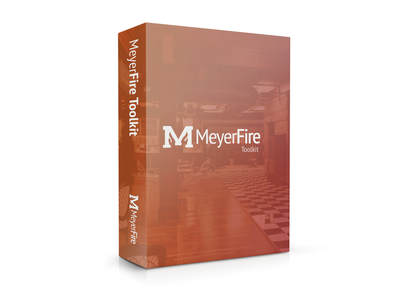|
I have a project with Miscellaneous Storage of Class I commodities up to 12'-0" and Group A plastics up to 5'-0".
The water supply is a tank fed from a well. Based on NFPA 13-2016 Table 13.2.1, I designed to Ordinary Hazard Group 2 with a 90 minute duration of available water. My original demand was 57 psi at 385 gpm. Our pump supplier provided a vertical in-line pump rated to 80 psi 400 gpm. The client is now unhappy about the volume of water being required so they are removing the Group A plastics from their building so we can calculate to OH I with the new demand being 41.5 psi at 304 gpm. We have already installed most of the system and the pump is ready to be delivered soon. Is it okay to have an oversized pump? Can it be limited to a smaller flow to accommodate the new demand? My worry is that it will flow at the rated capacity and if we are sizing our tanks 10,000 gallons less than originally planned we would run out of water. Sent in anonymously for discussion. Click Title to View | Submit Your Question | Subscribe
9 Comments
J Golden
2/26/2024 08:09:05 am
Side note;
Reply
sean
2/26/2024 01:16:11 pm
The code does not require that a tank include hose allowance as the system is not designed to support line personnel pulling off the same water supply (tank).
Reply
Jack G
2/26/2024 02:53:16 pm
I believe it’s only hose , or if a hose rack system the hose demand.
Reply
Dan Wilder
2/26/2024 08:15:18 am
Some thoughts
Reply
Glenn Berger
2/26/2024 08:19:43 am
A 400 gpm fire pump for a water demand of 385 gpm is not considered oversized. The pressure rating of 80 psi v. 57 psi could be a manufacturer available size.
Reply
Jack G
2/26/2024 08:55:01 am
Assuming the problem is 150% for 90 minutes and not having a large enough tank,
Reply
Jesse
2/26/2024 10:03:55 am
There used to be a day when we'd just throw a monster pump in a building and call it good.
Reply
Casey Milhorn
2/26/2024 03:17:01 pm
I think others have covered it fairly well.
Reply
Rodney
2/29/2024 04:48:00 am
An oversized pump is fine, but the tank should be sized according to the duty point, plus dead water and freeboard. There control valves can likewise be sized accordingly with pump delivery being restricted by using equivalent lengths of pipe, similar to an orifice plate but with a more linear flow impact. Essentially replacing a pre calculated length of distribution mains above the alarm valve with a smaller diameter pipe over the calculated length then reverting to the designed diameter. This solution provides for a quick correction of a system’s flow delivery characteristics where you have a fixed water supply and or need to adjust an existing system’s delivery curve.
Reply
Leave a Reply. |
ALL-ACCESSSUBSCRIBESubscribe and learn something new each day:
COMMUNITYTop March '24 Contributors
YOUR POSTPE EXAMGet 100 Days of Free Sample Questions right to you!
FILTERS
All
ARCHIVES
April 2024
PE PREP SERIES |
MeyerFire
- Blog
- Forum
-
THE TOOLKIT
- SUBMIT AN IDEA
- BACKFLOW DATABASE*
- CLEAN AGENT ESTIMATOR*
- CLOUD CEILING CALCULATOR
- DOMESTIC DEMAND*
- FIRE FLOW CALCULATOR*
- FIRE PUMP ANALYZER*
- FIRE PUMP DATABASE*
- FRICTION LOSS CALCULATOR
- HANGER SPACER*
- IBC TRANSLATOR*
- K-FACTOR SELECTOR*
- NFPA 13 EDITION TRANSLATOR ('19 ONLY)
- NFPA 13 EDITION TRANSLATOR ('99-'22)*
- LIQUIDS ANALYZER*
- OBSTRUCTION CALCULATOR
- OBSTRUCTIONS AGAINST WALL*
- PITOT CONVERTER
- PLUMBING FIXTURE COUNTS
- QUICK RESPONSE AREA REDUCTION
- REMOTE AREA ANALYZER*
- SPRINKLER DATABASE*
- SPRINKLER FLOW*
- SYSTEM ESTIMATOR*
- TEST & DRAIN CALCULATOR
- THRUST BLOCK CALCULATOR
- TRAPEZE CALCULATOR
- UNIT CONVERTER
- VOLUME & COMPRESSOR CALCULATOR
- WATER STORAGE*
- WATER SUPPLY (US)
- WATER SUPPLY (METRIC)
- UNIVERSITY
- PE Exam
- LOGIN
- PRICING
- OUR CAUSE

MeyerFire.com is a startup community built to help fire protection professionals shine.
Our goal is to improve fire protection practices worldwide. We promote the industry by creating helpful tools and resources, and by bringing together industry professionals to share their expertise.
MeyerFire, LLC is a NICET Recognized Training Provider and International Code Council Preferred Education Provider.
All text, images, and media Copyright © 2023 MeyerFire, LLC
We respect your privacy and personal data. See our Privacy Policy and Terms of Service. The views, opinions, and information found on this site represent solely the author and do not represent the opinions of any other party, nor does the presented material assume responsibility for its use. Fire protection and life safety systems constitute a critical component for public health and safety and you should consult with a licensed professional for proper design and code adherence.
Discussions are solely for the purpose of peer review and the exchange of ideas. All comments are reviewed. Comments which do not contribute, are not relevant, are spam, or are disrespectful in nature may be removed. Information presented and opinions expressed should not be relied upon as a replacement for consulting services. Some (not all) outbound links on this website, such as Amazon links, are affiliate-based where we receive a small commission for orders placed elsewhere.













 RSS Feed
RSS Feed
